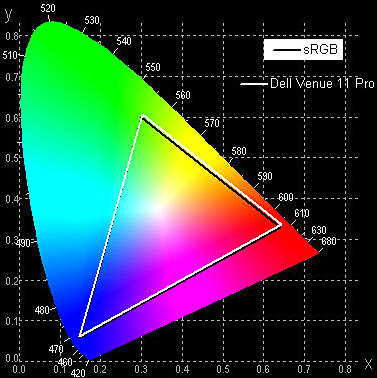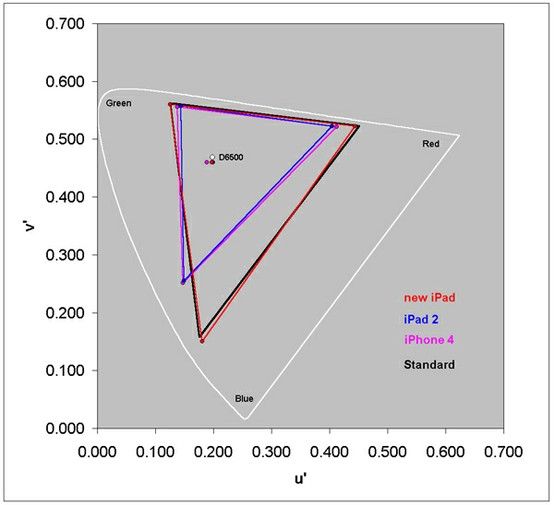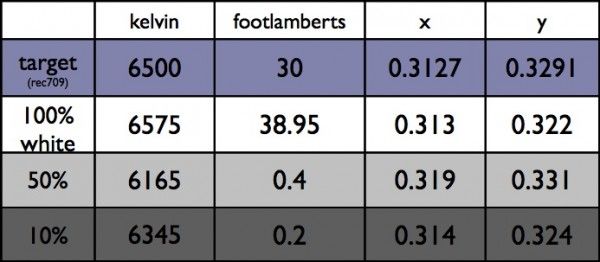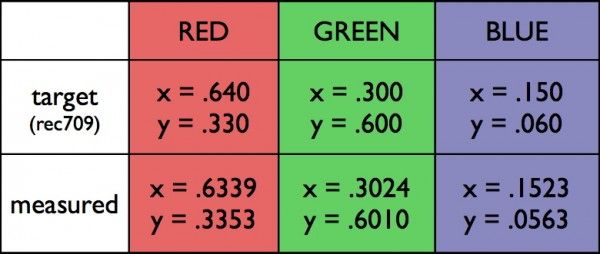
It allows to keep PV going, with more focus towards AI, but keeping be one of the few truly independent places.
-
Seriously, this thing is 99% close to the proper color gamut of rec709. (It's seems the white balance is a little cool, but nothing major.)
"...As Apple released the third generation iPad we saw two different reports suggesting that this new device had very accurate color – even describing it as being close to a professional broadcast monitor. That claim seemed like something we should check out so we loaded up an iPad 3 with normal test images and borrowed a Photo Research PR-650 SpectraScan Colorimeter to test it. Testing a $500 consumer device that has only a brightness control with a $12,000 Colorimeter – Hey why not?" Rest of article is here: http://www.fxphd.com/blog/just-how-good-is-the-ipads-color/
Also I've attached some color gamut comparisons from this article: http://www.negativespaces.com/blog/2012/3/27/new-ipads-color-gamut.html
Other useful articles: - http://michaelcioni.tumblr.com/post/19561057034/ipad-going-invisible - http://www.displaymate.com/iPad_ShootOut_1.htm
I know there is an ipad 3 thread, Vitaliy, so feel free to close this if you think it fits there. But I think it's maybe worth talking about and having people share their experiences of using the ipad 3 as a color reference device both on set and during color correction. So what do you think people?
It's true that we can't really use it as a "grading monitor" in the sense of connecting it to Davinci, BUT it provides a way to check any color grading you do on something that is basically as reliable as a broadcast monitor: you'll just have to take the extra steps of exporting a file (like h.264) for viewing on the iPad. Sure it's not perfect, but otherwise you'll have to spend over $2.5K to get a "professional" monitor.
The "measured" is the iPad 3.
-
Nec monitors are very very good and can be had for a song sometimes...
http://www.bhphotovideo.com/c/product/801273144-USE/nec_pa272w_bk_27_led_backlit.html
http://www.necdisplay.com/p/desktop-monitors/ea275uhd-bk-sv
P series are tops E series are good but maybe not as intensely accurate
-
Try Dell UP2716D.
-
Any recommendations for a good (in value) grading monitor somewhere around 1000 dollars? I'm tired with my HP Z24x Dreamcolor. Massive light leaks and green cast that I can't deal with.
-
Another portable monitoring option with good color accuracy - Dell Venue Pro 11

http://www.ebay.com/sch/iPads-Tablets-eBook-Readers-/171485/i.html?_from=R40&_nkw=dell+venue+11+pro

 nikon_v74.jpg377 x 378 - 33K
nikon_v74.jpg377 x 378 - 33K -
Have a look at the BMD Mini Monitor ($145) 10 bit HDMI and 10 bit HD-SDI, suppports FCP, AVID, Premier and After Effects. Makes the LUT Tables irrelevant, which is the way it should be.
An apology ... When i was in PC, It used to annoy me the way Mac people forgot that some of us were on PC. Now i am on Macs, I just did ... This is a thunderbolt device.
-
Jiayu G3 cheap chinese phone with 1280x720 IPS screen

-
Nexus 4 phone have almost perfect sRGB

-
I think we'll need to look more carefully on calibrating dual monitors. May be make separate topic.
As for Matrox, RGB mode is 8 bit, and 10 bit(plus 422 only) have no use with most monitors as I understand.
-
Can you show me this part in manual and that do you mean here?
http://www.matrox.com/video/en/products/mxo2/monitoring/
Added: After quick look normal cards have double LUTs. http://nvidia.custhelp.com/app/answers/detail/a_id/77
My "colleagues" under win7 (I'm a photoshop pro) have had really hard times with windows color control panel. It looks like only the profile for the main monitor is used by color-managed applications, so only pro video cards managing multiple profiles via their own drivers and utilities are a reliable solution.
-
Some calibrators can fail with wide gamut monitors.
DT-94 works perfect with Dell u2711 and Quato Excellence.
-
Modern Alpha IPS (or latest S-IPS from LG) panels have good contrast, not astonishing, but enough.
As for plasma. It has more issues than solutions.
First, afterglow still happens, especially if you have similar things on same places (like titles in news).
Second, color gradations rendering is quite specific, with modern panels it is not big issue, but you must always know it.
Third, brightness is not the same on different situations, If all scene is bright, overall brightness will go down.
-
From everything I have seen, IPS panel don't have a very high static contrast ratio as LCD screen in general. After a lot of research I see myself buying a blackmagic intensity pro with a plasma TV and a calibration system like calman. Panasonic plasma TV have very good reviews and are being used in post house. Unfortunately I only have old models (very expensive) or the very basic ones in my country. So I will go for this LG model
http://reviews.plasmatvbuyingguide.com/lg-plasma-tv/lg-55pa6500.html
http://www.avsforum.com/t/1390332/lg-50pa6500-and-lg-60pa6500-plasmas
-
I calibrated the monitor with x-rite DT94. Or at least I tried to beause I failed.
Some calibrators can fail with wide gamut monitors.
As for panel - Dell can't do anything, if LG is stopping producing some panel and replace it with slightly different one, it'll be different results. Even slight change of lamps (or leds) in backlight can add difference.
-
It is 2010 year review.
It's a 2010 monitor. The review appeared after introcuction of the Monitor. I bought mine in mid of 2011 and sold it in beginning of 2012. I do not know exactly but I doubt that Dell has changed this monitor in the meanwhile. I calibrated the monitor with x-rite DT94. Or at least I tried to beause I failed. It was no problem with U2711. I think it's not the problem of the panel but with electronics.
-
The point is that you need a graphic cards with a different LUT for each different output, plus a driver supporting that feature, if you wanna work in a dual monitor environment with one monitor just for the graded preview.
Right now it is zero problems to install even three cards. As even many cheap MBs allow it.
I'll check modern situation with dual LUT cards and let you know.
Added: After quick look normal cards have double LUTs.
http://nvidia.custhelp.com/app/answers/detail/a_id/77
In fact, if you are getting 27" or even 30" monitors, just get two monitors with sequental numbers, it will be enough, will work from single LUT.
10bit 4:2:2
Can you show me this part in manual and that do you mean here?
As very few monitors will accept 10bit signal, and you reall need RGB or 444 YCC.
-
LUT is defined by calibration app, so it is no different from graphic card.
The point is that you need a graphic cards with a different LUT for each different output, plus a driver supporting that feature, if you wanna work in a dual monitor environment with one monitor just for the graded preview.
So forget consumer cards and pro cards don't cost far less then a MXO2 mini.
It is also have same 8 bit output, most probably dithered
10bit 4:2:2
-
I dont know what you get "factory calibrated" but as I experienced color custom mode of this monitor is crap.
I got it from monitor page.
See a review in German here and see how big the divergence of delta E in the green channel is http://www.prad.de/new/monitore/test/2010/test-dell-u2410-teil8.html I sold this monitor and bought the U2711
It is 2010 year review. I have big doubts that despite same name it is exactly same monitor (as panles change quite frequently). Even 27" and 30" monitors use different panels. Plus few years ago I did check on few our local monitor reviews and measurements, most where highly inaccurate.
I also did not get slightly about your comments about crap. Did you have calibrator? As normally after switching to proper color mode, sRGB in this case, all you need to touch on monitor is only backlight strength.
-
Check this Ultrasharp deal (it is factory calibrated monitor) http://accessories.us.dell.com/sna/productdetail.aspx?c=us&l=en&s=soho&cs=ussoho1&sku=320-8277&dgc=BF&cid=7420&lid=197374
I had it and I was quite dissapointed. I dont know what you get "factory calibrated" but as I experienced color custom mode of this monitor is crap. You need this mode because in this mode RGB gain sliders are available and you can adjust your illuminant white with on-board settings. See a review in German here and see how big the divergence of delta E in the green channel is http://www.prad.de/new/monitore/test/2010/test-dell-u2410-teil8.html I sold this monitor and bought the U2711
I'd highly recommend to go for the U2711 or spend some morr bucks for the NEC PA241W
-
Let me say this. Grading and choosing monitor is not religion based. It is based on simple logic and principles. And his statement is mostly not based on logic (exn expample that follow is just bullshit mostly). History of "you need broadcast monitor" goes way back. In the time than cheap, big, good and even calibrated on factory IPS based monitors existed only in dreams.
-
@Vitaliy_Kiselev Great find! I'll look into it... Could be really nice as a set-monitor too. :)
This video is a good example of what I hear color correction pros says (Alexis van Hurkman wrote "The Color Correction Handbook"). He mentions that when grading for the web, a calibrated computer display is perfect, but for broadcast "you need to have a broadcast monitor". The part of the video starts at 1:00:36, which should link to directly with this link (though it won't I see):
-
Check this Ultrasharp deal (it is factory calibrated monitor)
-
Hmm... after some searching it is surprisingly difficult to find a clear article or discussion of the differences between a calibrated (IPS) computer monitor and a professional color grading monitor.... ??? If you really can get pretty close with a calibrated IPS at home, and then have an important project, you can buy a small amount of time with a professional to do the final tweaks on what you did at home....
It does seem that in terms of computer monitors it's good to get something that's capable of being very close to sRGB....
I've read that this ASUS monitors is very good for that:
http://www.amazon.com/exec/obidos/ASIN/B005HIRG52/
I'm torn between that and another 27" IPS Korean monitor (which I really love)... is there any reports on sRGB fidelity for these monitors? I also want to use Resolve, and I need to see if I require a monitor with something other than DVI to be able to have a reference monitor feed from Resolve (via Intensity Pro card I guess). The Asus has hdmi which is one advantage.
I also realized that perhaps the Ipads eventually loose their calibration... and then you have no tools to recalibrate them! Hmmm...
-
LUT is defined by calibration app, so it is no different from graphic card. It is also have same 8 bit output, most probably dithered.
-
And what is the point to get external device that effectively do the same that video card LUT?
I may be wrong but I think devices like those have got specific LUT for the task and/or can let you "play" with and adjust their LUT.
Howdy, Stranger!
It looks like you're new here. If you want to get involved, click one of these buttons!
Categories
- Topics List23,913
- Blog5,718
- General and News1,332
- Hacks and Patches1,148
- ↳ Top Settings33
- ↳ Beginners254
- ↳ Archives402
- ↳ Hacks News and Development56
- Cameras2,342
- ↳ Panasonic984
- ↳ Canon118
- ↳ Sony154
- ↳ Nikon95
- ↳ Pentax and Samsung70
- ↳ Olympus and Fujifilm98
- ↳ Compacts and Camcorders295
- ↳ Smartphones for video96
- ↳ Pro Video Cameras191
- ↳ BlackMagic and other raw cameras116
- Skill1,959
- ↳ Business and distribution66
- ↳ Preparation, scripts and legal38
- ↳ Art149
- ↳ Import, Convert, Exporting291
- ↳ Editors190
- ↳ Effects and stunts115
- ↳ Color grading197
- ↳ Sound and Music280
- ↳ Lighting96
- ↳ Software and storage tips266
- Gear5,407
- ↳ Filters, Adapters, Matte boxes344
- ↳ Lenses1,577
- ↳ Follow focus and gears93
- ↳ Sound496
- ↳ Lighting gear313
- ↳ Camera movement230
- ↳ Gimbals and copters302
- ↳ Rigs and related stuff271
- ↳ Power solutions83
- ↳ Monitors and viewfinders339
- ↳ Tripods and fluid heads139
- ↳ Storage286
- ↳ Computers and studio gear559
- ↳ VR and 3D248
- Showcase1,859
- Marketplace2,834
- Offtopic1,314










